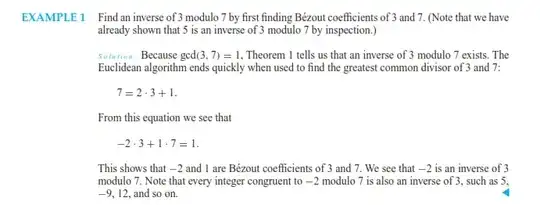This is an example from Discrete Mathematics and its Applications

This is example 1 that this example references

And here's Theorem 1 that the example references

Example 1 makes sense. We have to determine if the inverse of 3 modulo 7 exists first of all. It will exist based on theorem 1 if m > 1, which it is in this case bc m = 7 and if gcd(3, 7) is 1 - definition of relatively prime.
To determine if gcd(3, 7) is 1, you can use Euclid's Algorithm,
7 = 3(2) + 1
3 = 1(3) + 0
In this case, 1 is the gcd because it is last remainder before the remainder goes to zero. $\equiv$
Now you know the inverse exists. To find the actual inverse, you want the inverse to be in the form
a'a $\equiv$ 1 $\bmod$ m
where a' would be the inverse.
To do this, you would need to use Bezout's Theorem that gcd(a, b) = sa + tb, so from my work in Euclid's Theorem, you can see
7 = 3(2) + 1
-2(3) + 1(7) = 1
then
-2(3) - 1 = -1(7)
-2(3) $\equiv$ 1$\bmod$(7) which is in the form of a'a $\equiv$ 1 $\bmod$ m, so a' or the inverse of a modulo m is -2.
Here's where I get lost. In example 3, the author uses the result he got from the inverse to solve the linear congruence of 3x $\equiv$ 4(mod 7).
I understand that -6 $\equiv$ 1 ($\bmod$ 7) and -8 $\equiv$ 6 ($\bmod$ 7), but how does that lead to x $\equiv$ -8 $\equiv$ 6 ($\bmod$ 7)? What does that even mean?